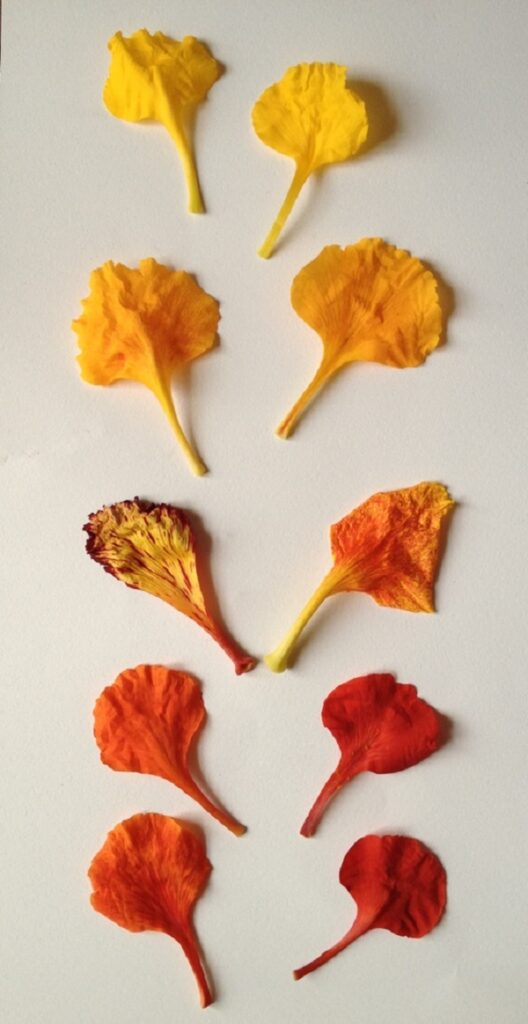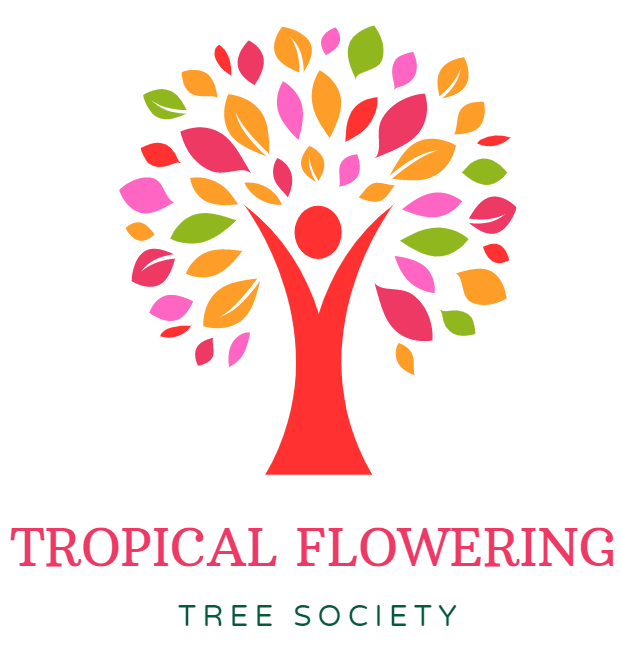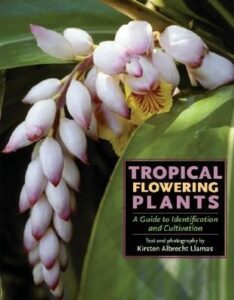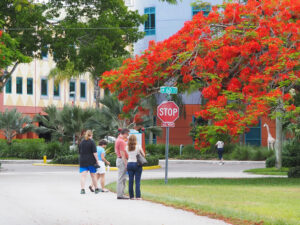DELONIX REGIA – ITS COLOR SPECTRUM

ALL of you are familiar with the Royal Poinciana, and MOST of you know that it is the official
flowering tree of Miami-Dade County. MANY of you know that it is a native of Madagascar, and
SOME of you know that we have more Poincianas in Miami-Dade County than there are in
Madagascar, only because we are busy planting new seedlings and grafted plants every year, while they are busy cutting or burning them!
But how many of you know that this member of the Caesalpinoid group of the Legume family
(Fabaceae) has a wide spectrum of flower colors? Other members of this group are Amherstia,
Bauhinia, Brownea, Cassia and Caesalpinia. The Latin word Delonix means clawed (the lip or
standard is like an open claw that attracts pollinators), and Regia means Royal.
The genus Delonix has 10 species of trees which are native to Madagascar, Africa and India. They thrive in areas of the tropics and warm subtropics that have humid climates, combined with mild, dry winters.
The new flowers begin to open at midnight and are usually fully open by 9:00 a.m. the next morning.
The white petal (claw) with dark spots or lines, which attracts the pollinator, curls up and falls off the
next day, leaving only the plain-colored petals. At this point the flowers have no nectar or viable pollen.
The yellow pollen from the anthers sticks to the beaks of birds or even feathers, when they gather nectar
from the freshly open flowers, and pollinate the sticky stigmas of other flowers in their search for more
of the sweet-tasting nectar.
Poincianas flower at different times of the year, depending on rainfall patterns. In Miami, we celebrate
the Royal Poinciana Fiesta during the first or second weekend of June, but there is no guarantee that
trees will be in full flower at that specific time. For example, a cold winter can delay flowering by a
couple of weeks, and a dry spring (like we had this year) can stimulate an explosion of blossoms.
Wenzel Bojer, the Dutch botanist who first observed the Poinciana in the northwest part of Madagascar
in 1824, described the flower color as “bright scarlet.” In Miami-Dade County, we have flowers that are
scarlet, fire engine red, red, pumpkin, orange, golden yellow, canary yellow, plus subtle shades in
between. “Kampong yellow” from Guyana has canary yellow flowers with a white standard and pinkish
anthers. It can only be reproduced a-sexually because the seeds are not viable.
Most of these observations in Miami were made during the past 12-15 years, and the Tropical
Flowering Tree Society is pursuing its search for cultivars noted for their dazzling color and prolific
flowering. We are now a-sexually reproducing some of the more desirable selections by grafting or
tissue culture. Just imagine a street or avenue planted with one of these outstanding cultivars–all
exploding into color simultaneously!
Washington, DC has its famous Cherry Blossoms (David Fairchild introduced them to Washington from
Japan). Atlanta is ablaze when the Dogwoods are in bloom. Portland, Oregon is noted for its roses…
Why not South Florida for its Poincianas?!
Delonix elata has smaller flowers than Delonix regia, and leaflets that are 11⁄2” long. It is native from
Ethiopia to Egypt and India. Flowers are white, but fade to yellow. They have 4″ red stamens. The tree
grows to about 30 feet tall, with a yellowish even-grained wood, which has been used for cabinet-
making. It is extremely drought-tolerant. Therefore, an excellent xeriscape plant, as are most of the
tropical flowering trees. In fact, it is dry weather than stresses trees to flower and ultimately set fruit, so
as to guarantee their survival.
Bill Krome said that the first trees early settlers in the Redlands planted in their new “homesteads” were
avocados, mangos and Royal Poincianas. So the Royal Poinciana is a pioneer among the flowering
trees in Miami-Dade County. The plantings along South Miami Avenue were done in 1929.
According to the late Dr. Richard Howard, Professor Emeritus, Harvard University, the best flower color
combinations are found on the island of St. Maarten. Today, Miami-Dade County is way ahead in this
category, only because of the tremendous increase in germplasm introductions from around the world,
which has resulted in many unusual color combinations in the yellow, orange and red spectrum. The
Royal Poinciana Fiesta, which has been celebrated for 74 years in Miami-Dade County, is the longest-
running festival in South Florida.
The first Royal Poinciana tree planting day in Miami-Dade County was arranged by Wade Livingston
Street when he provided Poinciana seedlings to Miami Mayor Robert Williams on July 20, 1937. That
even inspired Mrs. Alvie Lindborg, secretary of the Coral Gables Chamber of Commerce, to contact
many civic organizations for financial support, and that in turn spawned the Annual Celebration of the
Blooming of the Royal Poinciana Trees.
In 1929, with encouragement from Dr. David Fairchild, there was a mass planting of Poincianas by
the City along South Miami Avenue and its environs. By July of 1938 these trees were in full bloom and
aroused a lot of attention.
By 1940, the popularity of this flamboyant tree in the Miami area had generated tremendous local
excitement. Wade Street was succeeded as Chairperson by Mrs. M.V. Wittichen, past-President of the
Miami Women’s Club, and she “developed it into one of the summer’s outstanding events.” The
celebrations lasted for a whole week. It was unanimously decided to change the name of the event to the
Royal Poinciana Festival in 1940.
The first Royal Poinciana Queen was Virginia Allen of Miami Beach and the University of Miami. This
tradition continues to this day, with scholarships awarded to the Queen and her Court by the Tropical
Flowering Tree Society.
The oldest recognized Royal Poinciana tree in Miami-Dade County was planted by Marian Fairchild at
The Kampong in 1917.
The Royal Poinciana (also known as the Flamboyante, Flame tree, Peacock flower, Arbol del Fuergo,
Gul Mohur (India), Ohai-Ula (Hawaii) and the Pride of Dade County) is one of the most spectacular
flowering trees in the USA, and probably among the top 10 on this planet. In full bloom, it is like a
regal elephant caparisoned in red and yellow brilliance.
Larry M. Schokman
Director Emeritus, The Kampong
National Tropical Botanical Garden





